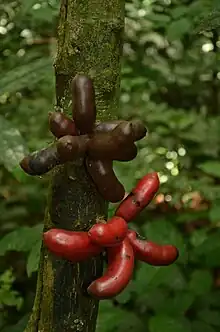Uvariopsis guineensis
Uvariopsis guineensis is a species of plant in the Annonaceae family. It is native to Guinea, Ivory Coast, Liberia, and Sierra Leone.[3] Ronald William John Keay, the botanist who first formally described the species, named it after Guinea, then called French Guinea, where the specimens he examined were collected near a locality he identifies as Fassakoidou.[4]
| Uvariopsis guineensis | |
|---|---|
 | |
| Photograph of Uvariopsis guineensis with fruit.[1] | |
| Scientific classification | |
| Kingdom: | Plantae |
| Clade: | Tracheophytes |
| Clade: | Angiosperms |
| Clade: | Magnoliids |
| Order: | Magnoliales |
| Family: | Annonaceae |
| Genus: | Uvariopsis |
| Species: | U. guineensis |
| Binomial name | |
| Uvariopsis guineensis | |
Description
It is tree reaching 10.7 meters in height. Its flowers occur clusters on the lower trunk. The very fragrant flowers are on hairless pedicel that are 20 by 4 millimeters. Its flowers have bi-lobed sepals that are 11-12 millimeters in diameter. Its flowers have 4 fleshy, oval to triangular petals that are 5-6 millimeters thick and 18-20 by 14-17 millimeters. The petals are united at their base for 5-7 millimeters. The petals are hairless inside, green on their outer surface and yellow inside. Male flowers have a mass of densely packed, brownish stamens that are collectively 5 millimeters in diameter. The fruit are positioned low on the trunk, near ground level. The fruit are on pedicels that are 6.5 centimeters long. The red fruit are irregular in shape and up to 4.5 centimeters long.[4][5]
Reproductive biology
The pollen of Uvariopsis guineensis is shed as permanent tetrads.[6]
Uses
Based on interviews with traditional healers in Guinea it has been recorded as being used to treat skin ailments.[7]
References
- "Uvariopsis guineensis Keay". Tropicos. Tropicos.org. Missouri Botanical Garden. n.d. Retrieved August 20, 2023.
- Harvey-Brown, Y. (2019). "Uvariopsis guineensis". IUCN Red List of Threatened Species. 2019: e.T85730032A149068563. doi:10.2305/IUCN.UK.2019-2.RLTS.T85730032A149068563.en. Retrieved 14 June 2022.
- "Uvariopsis guineensis Keay". Plants of the World Online. The Trustees of the Royal Botanic Gardens, Kew. n.d. Retrieved June 14, 2022.
- Keay, R.W.J. (1952). "Revision of the "Flora of West Tropical Africa": I". Kew Bulletin. 7 (2): 149–165. doi:10.2307/4109256. JSTOR 4109256.
- Hutchinson, J.; Dalziel, J.M. (1954). Flora of West Tropical Africa. Vol. 1: part 1. London: Crown Agents for Oversea Governments and Administrations.
- Walker, James W. (1971). "Pollen Morphology, Phytogeography, and Phylogeny of the Annonaceae". Contributions from the Gray Herbarium of Harvard University. 202 (202): 1–130. doi:10.5962/p.272704. JSTOR 41764703. S2CID 249081277.
- Baldé, Mamadou Aliou; Tuenter, Emmy; Traoré, Mohamed Sahar; Matheeussen, An; Cos, Paul; Maes, Louis; Camara, Aïssata; Haba, Nyanga Luopou; Gomou, Kalaya; Diallo, Mamadou Saliou Telly; Baldé, Elhadj Saïdou; Pieters, Luc; Balde, Aliou Mamadou; Foubert, Kenn (2020). "Antimicrobial investigation of ethnobotanically selected guinean plant species". Journal of Ethnopharmacology. 263: 113232. doi:10.1016/j.jep.2020.113232. hdl:10067/1705260151162165141. PMID 32768641. S2CID 221084843.
